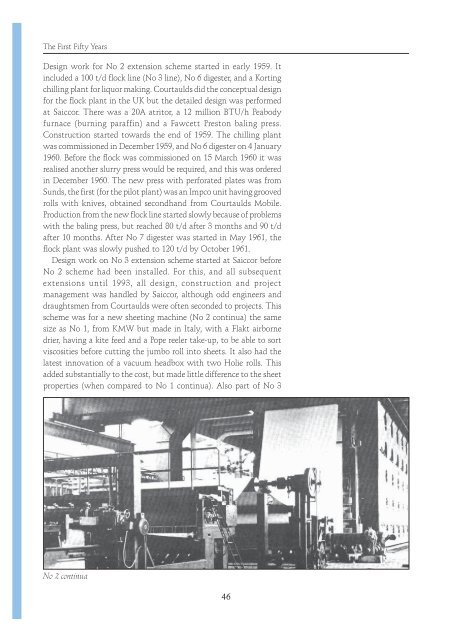You also want an ePaper? Increase the reach of your titles
YUMPU automatically turns print PDFs into web optimized ePapers that Google loves.
<strong>The</strong> <strong>First</strong> Fifty <strong>Years</strong><br />
Design work for No 2 extension scheme started in early 1959� It<br />
included a 100 t/d flock line (No 3 line), No 6 digester, and a Korting<br />
chilling plant for liquor making� Courtaulds did the conceptual design<br />
for the flock plant in the UK but the detailed design was performed<br />
at <strong>Saiccor</strong>� <strong>The</strong>re was a 20A atritor, a 12 million BTU/h Peabody<br />
furnace (burning paraffin) and a Fawcett Preston baling press�<br />
Construction started towards the end of 1959� <strong>The</strong> chilling plant<br />
was commissioned in December 1959, and No 6 digester on 4 January<br />
1960� Before the flock was commissioned on 15 March 1960 it was<br />
realised another slurry press would be required, and this was ordered<br />
in December 1960� <strong>The</strong> new press with perforated plates was from<br />
Sunds, the first (for the pilot plant) was an Impco unit having grooved<br />
rolls with knives, obtained secondhand from Courtaulds Mobile�<br />
Production from the new flock line started slowly because of problems<br />
with the baling press, but reached 80 t/d after 3 months and 90 t/d<br />
after 10 months� After No 7 digester was started in May 1961, the<br />
flock plant was slowly pushed to 120 t/d by October 1961�<br />
Design work on No 3 extension scheme started at <strong>Saiccor</strong> before<br />
No 2 scheme had been installed� For this, and all subsequent<br />
extensions until 1993, all design, construction and project<br />
management was handled by <strong>Saiccor</strong>, although odd engineers and<br />
draughtsmen from Courtaulds were often seconded to projects� This<br />
scheme was for a new sheeting machine (No 2 continua) the same<br />
size as No 1, from KMW but made in Italy, with a Flakt airborne<br />
drier, having a kite feed and a Pope reeler take-up, to be able to sort<br />
viscosities before cutting the jumbo roll into sheets� It also had the<br />
latest innovation of a vacuum headbox with two Holie rolls� This<br />
added substantially to the cost, but made little difference to the sheet<br />
properties (when compared to No 1 continua)� Also part of No 3<br />
No 2 continua<br />
46

















